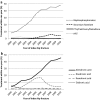Anti-osteoporosis drug prescribing after hip fracture in the UK: 2000-2010
- PMID: 25963232
- PMCID: PMC4483189
- DOI: 10.1007/s00198-015-3098-x
Anti-osteoporosis drug prescribing after hip fracture in the UK: 2000-2010
Abstract
The probability of initiating with anti-osteoporosis therapy increased from 7 % in 2000 to 46 % in 2010. This improvement was greater for patients over the age of 75 years. Men, those overweight, having dementia or exposed to antipsychotics, sedatives/hypnotics or opioid analgesics were significantly less likely to receive anti-osteoporosis drugs.
Introduction: The objective of this study was to examine trends and determinants of anti-osteoporosis drug prescribing after hip fracture in the UK between 2000 and 2010.
Methods: Data were extracted from the UK Clinical Practice Research Datalink for patients ≥50 years who had a first hip fracture between 2000 and 2010 and who did not currently (≤6 months prior) receive anti-osteoporosis drugs (bisphosphonates, strontium ranelate, parathyroid hormone, calcitonin and raloxifene) (n = 27,542). The cumulative incidence probability of being prescribed anti-osteoporosis drugs within 1 year after hip fracture was estimated by Kaplan-Meier life-table analyses. Determinants for treatment initiation were estimated by Cox proportional hazards models.
Results: The probability of being prescribed any anti-osteoporosis drug after hip fracture increased from 7 % in 2000 to 46 % in 2010. This trend was more marked in patients ≥75 years. The increase in prescribing of anti-osteoporosis drugs was complemented by a similar increase in vitamin D/calcium provision. Cumulative incidence of receiving anti-osteoporosis therapy was greater at any given point in time in women (8 % in 2000, 51 % in 2010) compared to men (4 % in 2000, 34 % in 2010). In addition to male gender, multivariable Cox regression identified reduced likelihood of receiving anti-osteoporosis drugs for those being overweight, having dementia and exposed to psychotropic drugs (antipsychotics, sedatives/hypnotics) or opioid analgesics.
Conclusion: Although the prescribing of anti-osteoporosis drugs after hip fracture has increased substantially since 2000, the overall rate remained inadequate, particularly in men. With the continuing increase in the absolute number of hip fractures, further research should be made into the barriers to optimise osteoporosis management.
Figures



Similar articles
-
Use of anti-osteoporosis medication dispensing by patients with hip fracture: could we do better?Osteoporos Int. 2019 Sep;30(9):1817-1825. doi: 10.1007/s00198-019-05066-8. Epub 2019 Jun 29. Osteoporos Int. 2019. PMID: 31263921
-
Geographic variation in secondary fracture prevention after a hip fracture during 1999-2013: a UK study.Osteoporos Int. 2017 Jan;28(1):169-178. doi: 10.1007/s00198-016-3811-4. Epub 2016 Nov 3. Osteoporos Int. 2017. PMID: 27812809 Free PMC article.
-
Trends in drug prescribing for osteoporosis after hip fracture, 1995-2004.J Rheumatol. 2008 Feb;35(2):319-26. Epub 2007 Dec 1. J Rheumatol. 2008. PMID: 18061977 Free PMC article.
-
Osteoporosis: disease severity and consequent fracture management.Osteoporos Int. 2010 Jun;21 Suppl 2:S425-9. doi: 10.1007/s00198-010-1251-0. Epub 2010 May 13. Osteoporos Int. 2010. PMID: 20464376 Review.
-
Identification and management of patients at increased risk of osteoporotic fracture: outcomes of an ESCEO expert consensus meeting.Osteoporos Int. 2017 Jul;28(7):2023-2034. doi: 10.1007/s00198-017-4009-0. Epub 2017 Apr 27. Osteoporos Int. 2017. PMID: 28451733 Free PMC article.
Cited by
-
The current situation in the approach to osteoporosis in older adults in Turkey: areas in need of improvement with a model for other populations.Arch Osteoporos. 2021 Nov 30;16(1):179. doi: 10.1007/s11657-021-01038-w. Arch Osteoporos. 2021. PMID: 34846612 Review.
-
Imminent fracture risk assessments in the UK FLS setting: implications and challenges.Arch Osteoporos. 2019 Feb 2;14(1):12. doi: 10.1007/s11657-019-0569-2. Arch Osteoporos. 2019. PMID: 30712158 Free PMC article.
-
Fragility fractures in Europe: burden, management and opportunities.Arch Osteoporos. 2020 Apr 19;15(1):59. doi: 10.1007/s11657-020-0706-y. Arch Osteoporos. 2020. PMID: 32306163 Free PMC article.
-
Use of anti-osteoporosis medication dispensing by patients with hip fracture: could we do better?Osteoporos Int. 2019 Sep;30(9):1817-1825. doi: 10.1007/s00198-019-05066-8. Epub 2019 Jun 29. Osteoporos Int. 2019. PMID: 31263921
-
Multicenter Study on Observation of Acute-phase Responses After Infusion of Zoledronic Acid 5 mg in Chinese Women with Postmenopausal Osteoporosis.Orthop Surg. 2017 Aug;9(3):284-289. doi: 10.1111/os.12338. Orthop Surg. 2017. PMID: 28960821 Free PMC article.
References
-
- National osteoporosis society, URL: http://www.nos.org.uk/page.aspx?pid=328 Accessed 22 January 2015
-
- Smith P, Ariti C, Bardsley M. Focus on hip fracture: trends in emergency admission for fractured neck of femur, 2001 to 2011. London: Nuffield Trust/Health Foundation; 2013.
Publication types
MeSH terms
Substances
Grants and funding
LinkOut - more resources
Full Text Sources
Other Literature Sources
Medical

